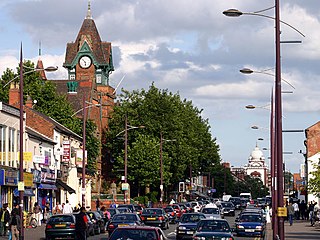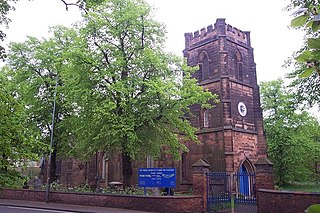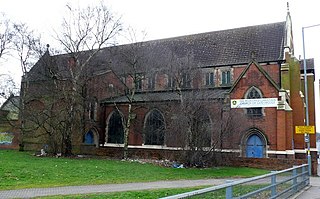Related Research Articles

The West Midlands sometimes referred to as the "West Midlands County" is a metropolitan county in the West Midlands Region, England with a 2020 estimated population of 2,939,927, making it the second most populous county in England after Greater London. It appeared as a metropolitan county in 1974 after the passage of the Local Government Act 1972, to cover parts of Staffordshire, Worcestershire and Warwickshire. The county is a NUTS 2 region within the wider NUTS 1 region of the same name. It embraces seven metropolitan boroughs: the cities of Birmingham, Coventry and Wolverhampton, and the boroughs of Dudley, Sandwell, Solihull and Walsall. The county is also a combined authority which is over seen by the West Midlands Combined Authority which covers all seven boroughs and other non-constituent councils on economy, transport and housing.

Augustus Welby Northmore Pugin was an English architect, designer, artist and critic who is principally remembered for his pioneering role in the Gothic Revival style of architecture. His work culminated in designing the interior of the Palace of Westminster in Westminster, London, England, and its iconic clock tower, later renamed the Elizabeth Tower, which houses the bell known as Big Ben. Pugin designed many churches in England, and some in Ireland and Australia. He was the son of Auguste Pugin, and the father of Edward Welby Pugin and Peter Paul Pugin, who continued his architectural firm as Pugin & Pugin. He also created Alton Castle in Alton, Staffordshire.

Tamworth is a market town and borough in Staffordshire, England, 14 miles (23 km) north-east of Birmingham and on the West Coast Main Line. The town borders North Warwickshire to the east and north, Lichfield to the north, south-west and west. The M6 Toll runs to the south of the town. It takes its name from the River Tame, which flows through it. The population of Tamworth borough (mid-2019 est.) was 76,696. The wider urban area has a population of 81,964.

Daventry is a market town and civil parish in the West Northamptonshire unitary authority in Northamptonshire, England, close to the border with Warwickshire. At the 2011 Census Daventry had a population of 25,026, making it the sixth largest town in Northamptonshire.

The West Midlands is one of nine official regions of England at the first level of International Territorial Level for statistical purposes. It covers the western half of the area traditionally known as the Midlands. The region consists of the counties of Herefordshire, Shropshire, Staffordshire, Warwickshire, West Midlands and Worcestershire. The largest city in the region is Birmingham.

Sutton Coldfield or the Royal Town of Sutton Coldfield, known locally as Sutton, is a large town and civil parish in Birmingham, England. The town lies around 8 miles northeast of Birmingham city centre, 9 miles south of Lichfield, 7 miles southwest of Tamworth and 7 miles east of Walsall. Sutton Coldfield and its surrounding suburbs are governed under Birmingham City Council for local government purposes but the town has its own town council which governs the town and its surrounding areas by running local services and electing a mayor to the council.

Handsworth is a suburban town and also an inner-city, urban area of northwest Birmingham in the West Midlands. Historically in Staffordshire, Handsworth lies just outside Birmingham City Centre.

Harborne is an area of south-west Birmingham, England. It is one of the most affluent areas of the Midlands, three miles southwest from Birmingham city centre. It is a Birmingham City Council ward in the formal district and in the parliamentary constituency of Birmingham Edgbaston.

This article is about the government of Birmingham, England.

St Mary's Church, Handsworth, also known as Handsworth Old Church, is a Grade II* listed Anglican church in Handsworth, Birmingham, England. Its ten-acre (4 hectare) grounds are contiguous with Handsworth Park. It lies just off the Birmingham Outer Circle, and south of a cutting housing the site of the former Handsworth Wood railway station. It is noteworthy as the resting place of famous progenitors of the industrial age, and has been described as "the cathedral of the Industrial Revolution".

The Church of St Agatha is a parish church in the Church of England in Sparkbrook in Birmingham, England.
Richard Charles Hussey, often referred to as R. C. Hussey, was a British architect. He was in partnership with Thomas Rickman from 1835, whose practice he assumed in 1838 with the latter's failing health; Rickman died on 4 January 1841.

Wolverhampton is a city, metropolitan borough and administrative centre in the West Midlands, England. At the 2011 census, it had a population of 249,470. People from the city are called "Wulfrunians".

Scouting in West Midlands provides an overview of Scouting activities in the governmental region of the West Midlands. The largest number of Scouts and volunteer leaders in the region is linked to the Scout Association of the United Kingdom, while there is also a presence of traditional Scouting groups, such as the Baden-Powell Scouts' Association. The Scout Association administers the region through 8 Scout Counties, overseen by a regional commissioner, which follow the boundaries of the ceremonial counties they exist within. There are also a number of Scouting clubs within Universities in the region which are affiliated to the Student Scout and Guide Organisation.

St Paul's is a Church of England church in the Georgian St Paul's Square in the Jewellery Quarter, Birmingham, England.

St John the Evangelist's Church, Perry Barr is a Grade II listed parish church in the Church of England in the Perry Barr area of Birmingham, England.

St James' Church in Handsworth, Birmingham, England was erected as an Anglican church in 1838–1840 on land given by John Crockett of the nearby New Inns Hotel. The architect was Robert Ebbles of Wolverhampton, who specialised in Gothic Revival churches. A new chancel was added in 1878 and the building was rebuilt in 1895, to designs by J. A. Chatwin. The original chancel thus became the north chapel, the original nave became the north aisle, and the original western tower was redesignated as the north-west tower. The additions were a new chancel, a nave, and a south aisle. Chatwin's Decorated style, red-brick features contrasted with the Early English style stonework of the original building.

St Luke's Church, Bristol Street, Birmingham was a former parish church in the Church of England in Birmingham, later used by the Redeemed Christian Triumphant Church of God. The building was demolished in 2018 as part of a housing redevelopment project by Barratt Homes.
St Jude's Church, Birmingham is a former parish church in the Church of England in Birmingham.

Birmingham Market Hall was a municipal market hall in the Bull Ring area of Birmingham, England, from 1835 to 1940, when the interior and roof were destroyed by enemy bombing; although parts remained in use until final demolition in the 1960s.
References
- ↑ The Church of England Magazine, Volume 6. J. Burns, 1839. p.5.
- ↑ "Birmingham, The Ten Churches Fund". Coventry Herald. Coventry. 30 November 1838. Retrieved 1 March 2015.
- ↑ "Birmingham New Churches". Staffordshire Advertiser. Staffordshire. 8 December 1838. Retrieved 1 March 2015.